CHAPTER IX.
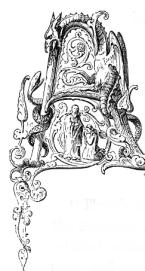
LITTLE more than two miles from the Mountain House, by a rough
road, is an immense gorge scooped from the rugged hills, into which pours
the gentle outlet of the little Katers-Kill lakes, in a fall first of one
hundred and seventy-five feet, and close to it another of eighty feet. The
falls have been so well described by the "Leather-stocking" ("Natty
Bumpo"), that a better picture cannot be drawn:--
"There's a place," said Natty, after describing the view from the Platform Rock at the Mountain House, "that in late times I relished better than the mountains, for it was more kivered by the trees, and more nateral."
"And where was that?" inquired Edwards.
"Why, there's a fall in the hills, where the water of two
little ponds, that lie near each other, breaks 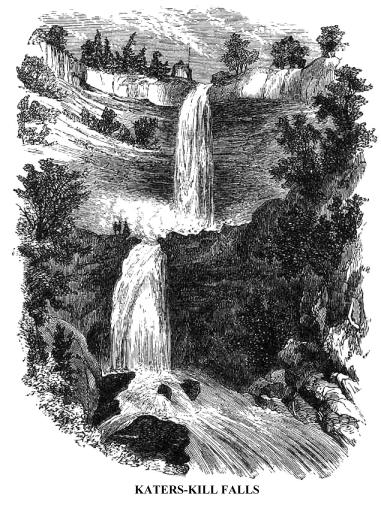 out
of their bounds, and runs over the rocks into the valley. The stream is, may
be, such a one as would turn a mill, if so useless a thing was wanted in the
wilderness. But the hand that made that 'Leap' never made a mill! There the
water comes crooking and winding among the rocks, first so slow that a trout
might swim in it, and then starting and running, just like any creature that
wanted to make a far spring, till it gets to where the mountain divides like
the cleft hoof of a deer, leaving a deep hollow for the brook to tumble into.
The first pitch is nigh two hundred feet, and the water looks like flakes
of driven snow afore it touches the bottom; and then the stream gathers itself
together again for a new start, and may be flutters over fifty feet of flat
rock, before it falls for another hundred, where it jumps about from shelf
to shelf, first turning this-a-way, and then turning that-a-way, striving
to get out of the hollow, till it finally comes to the plain..... The rock
sweeps like mason-work in a half-round on both sides of the fall, and shelves
over the bottom for fifty feet; so that when I've been sitting at the foot
of the first pitch, and my hounds have run into the caverns behind the sheet
of water, they've looked no bigger than so many rabbits. To my judgment, lad,
it's the best piece of work I've met with in the woods; and none know how
often the hand of God is seen in the wilderness, but them that rove it for
a man's life."
out
of their bounds, and runs over the rocks into the valley. The stream is, may
be, such a one as would turn a mill, if so useless a thing was wanted in the
wilderness. But the hand that made that 'Leap' never made a mill! There the
water comes crooking and winding among the rocks, first so slow that a trout
might swim in it, and then starting and running, just like any creature that
wanted to make a far spring, till it gets to where the mountain divides like
the cleft hoof of a deer, leaving a deep hollow for the brook to tumble into.
The first pitch is nigh two hundred feet, and the water looks like flakes
of driven snow afore it touches the bottom; and then the stream gathers itself
together again for a new start, and may be flutters over fifty feet of flat
rock, before it falls for another hundred, where it jumps about from shelf
to shelf, first turning this-a-way, and then turning that-a-way, striving
to get out of the hollow, till it finally comes to the plain..... The rock
sweeps like mason-work in a half-round on both sides of the fall, and shelves
over the bottom for fifty feet; so that when I've been sitting at the foot
of the first pitch, and my hounds have run into the caverns behind the sheet
of water, they've looked no bigger than so many rabbits. To my judgment, lad,
it's the best piece of work I've met with in the woods; and none know how
often the hand of God is seen in the wilderness, but them that rove it for
a man's life."
"Does the water run into the Delaware?" asked Edwards.
"No, no, it's a drop for the old Hudson: and a merry time it has until it gets down off the mountain."
And if the visitor would enjoy one of the wildest and most romantic rambles in the world, let him follow that little stream on its way "off the mountains," down the deep, dark, mysterious gorge, until it joins the Katers-Kill proper, that rushes through the "Clove" from the neighbourhood of Hunter, among the hills above, and thence onward to the plain.
It was just after a storm when we last visited these falls. The traces of "delicate-footed May" were upon every shrub and tree. Tiny leaves were just unfolding all over the mountains, and the snowy dogwood blossoms were bursting into beauty on every hand. Yet mementoes of winter were at the falls. In the cavern at the back of them, heaps of ice lay piled, and a chilling mist came sweeping up the gorge, at quick intervals, filling the whole amphitheatre with shadowy splendour when sunlight fell upon it from between the dissolving clouds. While sketching the cascades, memory recurred to other visits we had made there in midsummer, when the wealth of foliage lay upon tree and shrub; and also to a description given us by a lady, of her visit to the falls in winter, with Cole, the artist, when the frost had crystallized the spray into gorgeous fret-work all over the rocks, and made a splendid cylinder of milk-white ice from the base to the crown of the upper cascade. Of these phases Bryant has sung:--
"Midst greens and shades the Katers-Kill leaps,
From cliffs where the wood-flower clings;
All summer he moistens his verdant sleeps.
With the sweet light spray of the mountain springs:
And he shakes the woods on the mountain side,
When they drip with the rains of autumn tide.
"But when, in the forests bare and old,
The blast of December calls,
He builds, in the star-light clear and cold,
A palace of Ice, where his torrent falls,
With turret and arch, and fret-work fair,
And pillars blue as the summer air."
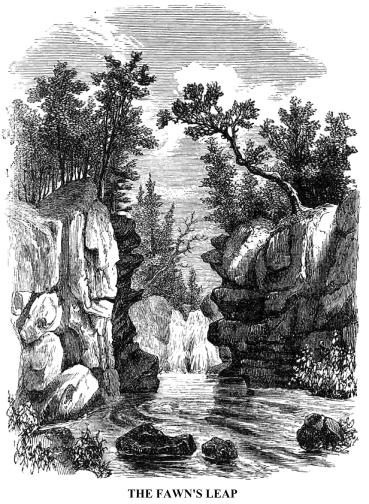 The
tourist, if he fails to traverse the rugged gorge, should not omit a ride
from the Mountain House, down through the "Clove" to Palensville
and the plain, a distance of about eight miles. Unpleasant as was the day
when we last visited the mountains, we returned to Katz-Kill by that circuitous
route. After leaving the falls, we rode about three miles before reaching
the "Clove." Huge masses of vapour came rolling up from its lower
depths, sometimes obscuring everything around us, and then, drifting away,
laving the lofty summits of the mountains that stretch far southward, gleaming
in the fitful sunlight, and presenting unsurpassed exhibitions of aerial perspective.
Down, down, sometimes with only a narrow space between the base of a high
mountain on one side, and steep precipices upon the other, whose feet are
washed by the rushing Katers-Kill, our crooked road pursued its way, now passing
a log-house, now a pleasant cottage, and at length the ruins of a leather
manufacturing village, deserted because the bark upon the hills around, used
for tanning, is exhausted. Near this picturesque scene, the Katers-Kill leaps
into a seething gulf between
The
tourist, if he fails to traverse the rugged gorge, should not omit a ride
from the Mountain House, down through the "Clove" to Palensville
and the plain, a distance of about eight miles. Unpleasant as was the day
when we last visited the mountains, we returned to Katz-Kill by that circuitous
route. After leaving the falls, we rode about three miles before reaching
the "Clove." Huge masses of vapour came rolling up from its lower
depths, sometimes obscuring everything around us, and then, drifting away,
laving the lofty summits of the mountains that stretch far southward, gleaming
in the fitful sunlight, and presenting unsurpassed exhibitions of aerial perspective.
Down, down, sometimes with only a narrow space between the base of a high
mountain on one side, and steep precipices upon the other, whose feet are
washed by the rushing Katers-Kill, our crooked road pursued its way, now passing
a log-house, now a pleasant cottage, and at length the ruins of a leather
manufacturing village, deserted because the bark upon the hills around, used
for tanning, is exhausted. Near this picturesque scene, the Katers-Kill leaps
into a seething gulf between 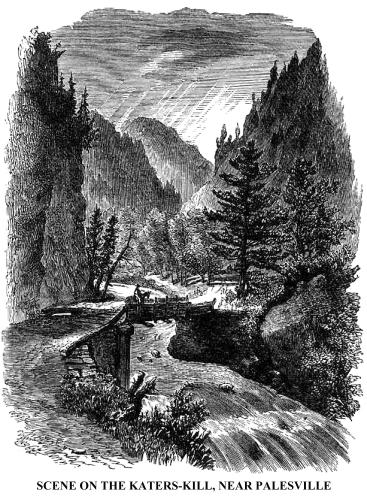 cleft
rocks, and flows gently on to make still greater plunges into darker depths
a short distance below. This cleft in the rocks is called the Fawn's Leap,
a young deer having there escaped a hunter and his dog, that pursued to the
verge of the chasm. The fawn leaped it, but the dog, attempting to follow,
fell into the gulf below and was drowned. The foiled hunter went home, without
dog or game. By some, less poetical than others, the place is called the Dog
Hole.
cleft
rocks, and flows gently on to make still greater plunges into darker depths
a short distance below. This cleft in the rocks is called the Fawn's Leap,
a young deer having there escaped a hunter and his dog, that pursued to the
verge of the chasm. The fawn leaped it, but the dog, attempting to follow,
fell into the gulf below and was drowned. The foiled hunter went home, without
dog or game. By some, less poetical than others, the place is called the Dog
Hole.
A few rods below the Fawn's Leap, the road crosses a rustic bridge, at the foot of a sheer precipice, and for half a mile traverses a shelf cut from the mountain side, two hundred feet above the stream that has found its way into depths so dark as to be hardly visible. Upon the opposite side of the creek a perpendicular wall rises many hundred feet, and then in slight inclination the mountain towers up at least a thousand feet higher, and forms a portion of the range known as the South Mountain. At the mouth of this cavernous gorge lies the pretty little village of Palensville, where we again cross the stream, and in a few moments find ourselves upon a beautiful and highly cultivated plain. From this point, along the base of the mountains to the road by which we enter them, or more directly to Katz-Kill, the drive is a delightful one.
From the lower borders of Columbia County, opposite Katz-Kill village, to Hyde Park, in Duchess County, a distance of thirty miles, the east bank of the Hudson is distinguished for old and elegant country seats, most of them owned and occupied by the descendants of wealthy proprietors who flourished in the last century, and were connected by blood and marriage with Robert Livingston, a Scotch gentleman, of the family of the Earls of Linlithgow, who came to America in 1672, and married a member of the Schuyler family, the widow of a Van Rensselaer. He lived at Albany, and was secretary to the Commissioners of Indian Affairs for a long time. From 1684 to 1715 he had, from time to time, purchased of the Indians, and secured by patents from the English crown, large tracts of land in the present Columbia County. This land was then mostly wild and unprofitable, but became the basis of great family wealth.
In the year 1710 Livingston's grants were consolidated, and Hunter, the royal governor, gave him a patent for a tract of a little more than one hundred and sixty-two thousand acres, for which he was to pay into the king's treasury "an annual rent of twenty-eight shillings, lawful money of New York," a trifle over fourteen shillings sterling! This magnificent estate was constituted a manor, with political privileges.
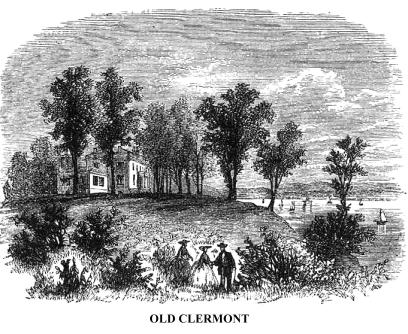 The
freeholders upon it were allowed a representative in the colonial legislature,
chosen by themselves, and in 1716 the lord of the manor, by virtue of that
privilege, took his seat as a legislator. He had already built a manor-house,
on a grassy point upon the banks of the Hudson, at the mouth of Roeleffe Jansen's
Kill, or Ancram Creek, of which hardly a vestige now remains.*
The
freeholders upon it were allowed a representative in the colonial legislature,
chosen by themselves, and in 1716 the lord of the manor, by virtue of that
privilege, took his seat as a legislator. He had already built a manor-house,
on a grassy point upon the banks of the Hudson, at the mouth of Roeleffe Jansen's
Kill, or Ancram Creek, of which hardly a vestige now remains.*
* In the year 1710 Governor Hunter, by order of Queen Anne, bought of Mr. Livingston 6,000 acres of his manor, for the sum or a little more than 200 pounds, for the use of Protestant Germans then in England, who had been driven from their homes in the Lower Palatinate of the Rhine, then the dominions of a cousin of the British Queen. About 1,800 of them settled upon the manor lands, and at a place on the opposite shore of the river, the respective localities being known as East and West Camp. These Germans were called Palatines, and are represented as the most enlightened people of their native land. Among them was the widow Hannah Zenger, who son, John Peter, apprenticed to William Bradford, the printer, became, in after life, the impersonation of the struggling democratic idea. He published a democratic newspaper, and because he commented freely upon the conduct of the royal governor, he was imprisoned and prosecuted for a libel. A jury acquitted him, in the midst of a great cheering by the people. His counsel was presented with the freedom of the city of New York in a gold box. By that verdict democratic ideas, and the freedom of the press, were nobly vindicated.
The lord of the manor gave, by his will, the lower portion
of his domain to his son Robert, who built 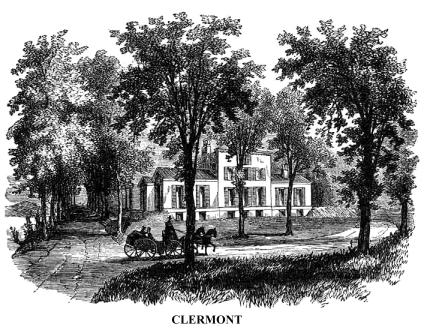 a
finer mansion than the old manor-house, and named his seat Clermont. This
was sometimes called the Lower Manor-house. There Robert R. Livingston, the
eminent Chancellor of the State of New York, and associate of Robert Fulton,
in his steamboat experiments, was born. After his marriage he built a dwelling
for himself, a little south of Old Clermont. His zeal in the Republican cause,
at the kindling of the revolution, made him an arch rebel in the estimation
of the British ministry and the officers in the service of the crown in America;
and when, in the autumn of 1777, General Vaughan, at the head of the royal
troops, went up the Hudson, on a marauding expedition, to produce a diversion
in favour of Burgoyne, then environed by the American army at Saratoga, they
proceeded as high as Clerment, burnt Livingston's new house, and the old one,
where he was born, and where his widowed mother resided, and then retreated
to New York. Mrs. Livingston immediately built another mansion at Old Clermont,
on the site of the ruins, which was occupied by Mr. Clermont Livingston when
these sketches were prepared, and her "rebel" son erected for himself
a more elegant one than that which had been destroyed, a little distance from
the ruins. This he named also Clermont.
a
finer mansion than the old manor-house, and named his seat Clermont. This
was sometimes called the Lower Manor-house. There Robert R. Livingston, the
eminent Chancellor of the State of New York, and associate of Robert Fulton,
in his steamboat experiments, was born. After his marriage he built a dwelling
for himself, a little south of Old Clermont. His zeal in the Republican cause,
at the kindling of the revolution, made him an arch rebel in the estimation
of the British ministry and the officers in the service of the crown in America;
and when, in the autumn of 1777, General Vaughan, at the head of the royal
troops, went up the Hudson, on a marauding expedition, to produce a diversion
in favour of Burgoyne, then environed by the American army at Saratoga, they
proceeded as high as Clerment, burnt Livingston's new house, and the old one,
where he was born, and where his widowed mother resided, and then retreated
to New York. Mrs. Livingston immediately built another mansion at Old Clermont,
on the site of the ruins, which was occupied by Mr. Clermont Livingston when
these sketches were prepared, and her "rebel" son erected for himself
a more elegant one than that which had been destroyed, a little distance from
the ruins. This he named also Clermont.
It was well preserved in its original style by the Misses Clarkson, the present proprietors. The mansion is beautifully situated, and, like all the villas in this neighbourhood, commands a fine prospect of the Katzbergs. It was described, as long ago as 1812, as "one of the most commodious houses in the State, having a river front of 104 feet, and a depth of 91 feet, and consisting of a main body of two stories and four pavilions," in one of which the chancellor had "a library of 4,000 well-chosen volumes." There he died in the spring of 1813.
"Mr. Livingston," says a contemporary, "was a very useful and benevolent man, a scholar of profound erudition, an ardent patriot, and a prompt and decided promoter of all the essential interests of the country." He took special interest in improvements in agriculture and manufactures, and on his return to the United States, from an embassy to France, at the beginning of the present century, he introduced into this country some of the finest specimens of the Merino sheep, from the celebrated flock of Rambouillet in France. As early as 1812, it was estimated that there were in the United States at least 60,000 descendants of the Clermont flock, of which about 1,000 were at Clermont.
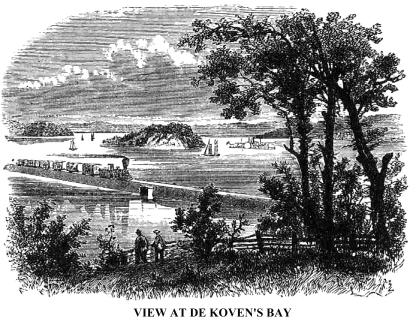 Mr.
Livingston's chief honour as a man of science, and promoter of useful interests,
is derived from his aid and encouragement in efforts which resulted in the
entire success of steam navigation. As early as 1797, he was engaged with
an Englishman named Nesbit in experiments. They built a steamboat on the Hudson
river, at a place now known as De Koven's Cove, or Bay, about half a mile
below Tivoli, or Upper Red Hook Landing. Brunel, the engineer of the Thames
Tunnel, and father of the originator and constructor of the Great Eastern
steamship, was the engineer. The enterprise was not successful. Livingston
entered upon other experiments, when he was interrupted by his appointment
as United States minister to the court of France. In Paris he became acquainted
with Robert Fulton's experiments there. With his science and money. Livingston
joined him. They succeeded in their undertaking, as proved by demonstrations
on the Seine, returned to America, and in 1806 imported a steam-engine, made
by Watt and Bolton, in England. A boat was constructed at Brown's ship-yard,
in New York, and was completed in August, 1807, when it was propelled by its
machinery to Hoboken, on the Jersey shore, where John Stevens (Mr. Livingston's
brother-in-law) had been experimenting in the same direction for fifteen years.
That first successful steamboat was named Clermont, in compliment to Chancellor
Livingston, and made her first voyage to Albany at the beginning of September,
1807.*
Mr.
Livingston's chief honour as a man of science, and promoter of useful interests,
is derived from his aid and encouragement in efforts which resulted in the
entire success of steam navigation. As early as 1797, he was engaged with
an Englishman named Nesbit in experiments. They built a steamboat on the Hudson
river, at a place now known as De Koven's Cove, or Bay, about half a mile
below Tivoli, or Upper Red Hook Landing. Brunel, the engineer of the Thames
Tunnel, and father of the originator and constructor of the Great Eastern
steamship, was the engineer. The enterprise was not successful. Livingston
entered upon other experiments, when he was interrupted by his appointment
as United States minister to the court of France. In Paris he became acquainted
with Robert Fulton's experiments there. With his science and money. Livingston
joined him. They succeeded in their undertaking, as proved by demonstrations
on the Seine, returned to America, and in 1806 imported a steam-engine, made
by Watt and Bolton, in England. A boat was constructed at Brown's ship-yard,
in New York, and was completed in August, 1807, when it was propelled by its
machinery to Hoboken, on the Jersey shore, where John Stevens (Mr. Livingston's
brother-in-law) had been experimenting in the same direction for fifteen years.
That first successful steamboat was named Clermont, in compliment to Chancellor
Livingston, and made her first voyage to Albany at the beginning of September,
1807.*
* The Clermont was 100 feet long, 12
feet wide, and 7 feet deep. The following advertisement appeared in the Albany
Gazette on the 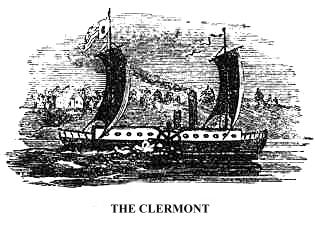 1st
of September 1807:--
1st
of September 1807:--
"The North River Steamboat will leave Paulus's Hook [Jersey City] on Friday, the 4th of September, at 9 in the morning, and arrive at Albany on Saturday, at 9 in the afternoon. Provisions, good berths, and accommodation are provided. The charge to each passenger is as follows:--
To Newburgh, Dollars, 3 Time, 14 hours.
To Poughkeepsie, Dollars, 4, Time 17 hours.
To Esopus, Dollars, 5, Time 20 hours.
To Hudson, Dollars , 5 1/2, 39 hours.
To Albany, Dollars, 7, Time 36 hours.
"Mr. Fulton's new steamboat," said the same paper, on the 5th of October, "left New York on the 2nd at 10 o'clock, A.M., against a strong tide, very rough water, and a violent gale from the north. She made headway, against the most sanguine expectations, and without being rocked by the waves!"
Copyright © 1998, -- 2004. Berry Enterprises. All rights reserved. All items on the site are copyrighted. While we welcome you to use the information provided on this web site by copying it, or downloading it; this information is copyrighted and not to be reproduced for distribution, sale, or profit.